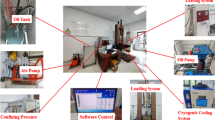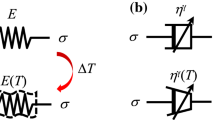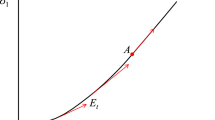Abstract
Creep is an important rheological behavior of coal, impacting pillar stability, gateway support performance, and construction costs in underground mining. It is of great significance to study the creep mechanism of coal to prevent creep failure. In this paper, uniaxial compressive creep tests of raw lean coal under multiple stages are conducted, the increasing instantaneous elastic modulus and decreasing viscosity coefficient are calculated to analyze the hardening-damage creep mechanism of coal, and some new conclusions are as follows. When the stress is low, the hardening effect exists, and coal strain shows an instantaneous response. At high stress, both the damage effect and hardening effect work and coal strain shows time-dependent transient creep and steady creep. During multistage creep, coal is first hardened, then weakened, and finally fails due to well-developed cracks. Based on the strain evolution laws of lean coal at different stress levels, an elastic viscous-plastic model is established, and the hardening function and damage function are introduced into the model to obtain an improved hardening-damage creep model. This model is used to fit the creep data, and the model curves match the testing data very well, showing much better accuracy than other models. This model is simple with clear physical meanings of the elements and can reflect the nonlinear hardening-damage creep of raw lean coal under uniaxial compression very well.









Similar content being viewed by others
References
Barla G, Bonini M, Debernardi D (2010) Time dependent deformations in squeezing tunnels. Int J Geoeng Case Histories 1:40–65
Brantut N, Heap MJ, Meredith PG, Baud P (2013) Time-dependent cracking and brittle creep in crustal rocks: a review. J Struct Geol 5:17–43
Cai MF, He MC, Liu DY (2009) Rock mechanics and engineering. Beijing: Science Press, 2009
Chen W, Kulatilake PHSW (2015) Creep behavior modeling of a marble under uniaxial compression. Geotech Geol Eng 33:1183–1191
Fahimifar A, Karami M, Fahimifar A (2015) Modifications to an elasto-visco-plastic constitutive model for prediction of creep deformation of rock samples. Soils Found 55(6):1364–1371
Fan QY, Yang KQ, Wang WM. (2010) Study of creep mechanism of argillaceous soft rocks. Chin J Rock Mech Eng, 29(8):1555–1561(in Chinese)
Fan QZ, Gao YF (2007) Study of creep properties and nonlinear creep model of soft rock. Chin J Rock Mech Eng 2007 26(2):391–396 (in Chinese)
Gao SH, Cao P, Wang SL, Pu CZ. (2012) Improved nonlinear visco elasto-plastic rheological model of rock and its correction of hardening coefficient of viscosity. J China Coal Soc, 37(6):936–943(in Chinese)
Haupt M (1991) A constitutive law for rock salt based on creep and relaxation tests. Rock Mech Rock Eng 24:179–206
Kachanov M (1992) Effective elastic properties of cracked sdids: cvitical reviews of some basic concepts. Appl Mech Rev 45(8):304–335
Kang JH, Zhou FB, Liu C, Liu YK (2015) A fractional non-linear creep model for coal considering damage effect and experimental validation. Int J Nonlin Mech 76:20–28
Li XC, Yang CL, Ren T, Nie BS, Zhao CH, Liu SW, Jiang T (2017) Creep behavior and constitutive model of coal filled with gas. Int J Min Sci Tech 27:847–851
Luo RL, Ruan HN, Zhu CX.(2008) Non-linear creep model based on plasticity strengthening and viscosity weakening of rock, J Southwest Jiaotong Univ, 43(3): 346–351(in Chinese)
Mishra B, Verma P (2015) Uniaxial and triaxial single and multistage creep tests on coal-measure shale rocks. Int J Coal Geol 137:55–65
Mu XY. (1990) Creep mechanics. Xi’an: Xi’an Jiaotong University press
Özşen H, Özkan İ, Şensöğüt C (2014) Measurement and mathematical modeling of the creep behavior of Tuzköy rock salt. Int J Rock Mech Min 66:128–135
Phienwej N, Thakur PK, Cording EJ (2007) Time-dependent response of tunnels considering creep effect. Int J Geomech 7(4):296–306
Pramthawee P, Jongpradist P, Sukkarak R (2017) Integration of creep into a modified hardening soil model for time-dependent analysis of a high rockfill dam. Comput Geotech 91:104–116
Song YJ, Lei SY, Liu XK. (2012) Non-linear rock creep model based on hardening and damage effect. J China Coal Soc 2012, 37(S2):287–292(in Chinese)
Ulusay R (2014) The ISRM suggested methods for rock characterization, testing and monitoring: 2007–2014, vol 1. Springer International Publishing, pp 47–48
Wang DK, Wei JP, Yin GZ, Wang YG, Wen ZH (2011) Triaxial creep behavior of coal containing gas in laboratory. Procedia Eng 26:1001–1010
Wang GJ, Zhang L, Zhang Y, Ding GS (2014) Experimental investigations of the creep-damage-rupture behavior of rock salt. Int J Rock Mech Min 66:181–187
Yang SQ, Jing HW, Cheng L (2014) Influences of pore pressure on short-term and creep mechanical behavior of red sandstone. Eng Geol 179:10–23
Yang SQ, Xu P, Ranjith PG (2015) Damage model of coal under creep and triaxial compression. Int J Rock Mech Min 80:337–345
Yu HD, Chen WZ, Gong Z, Tan XJ, Ma YS, Li XL, Sillen X (2015) Creep behavior of boom clay. Int J Rock Mech Min 76:256–264
Zhang Y, Xu WY, Shao JF, Zhao HB, Wang W (2015) Experimental investigation of creep behavior of clastic rock in Xiangjiaba hydropower project. Water Sci Eng 8(1):55–62
Zheng H, Feng XT, Hao XJ (2015) A creep model for weakly consolidated porous sandstone including volumetric creep. Int J Rocl Mech Min 78:99–107
Zhou HW, Wang CP, Han BB, Duan ZQ (2011) A creep constitutive model for salt rock based on fractional derivatives. Int J Rock Mech Min Sci 48:116–121
Acknowledgements
We thank the Springer Nature Author Services for its linguistic assistance during the preparation of this manuscript.
Funding
Support for this work is provided by the National Natural Science Foundation of China (No. 51704204) and San Jin scholars support plan by Shanxi Province, China (2017).
Author information
Authors and Affiliations
Corresponding author
Rights and permissions
About this article
Cite this article
Cai, T., Feng, Z. & Jiang, Y. An improved hardening-damage creep model of lean coal: a theoretical and experimental study. Arab J Geosci 11, 645 (2018). https://doi.org/10.1007/s12517-018-4012-6
Received:
Accepted:
Published:
DOI: https://doi.org/10.1007/s12517-018-4012-6




